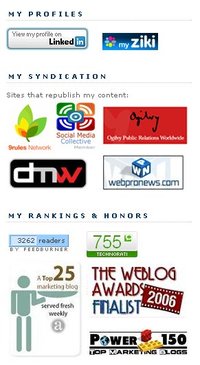
As with any trends like this, there are lots of opportunities for marketing if you understand what is motivating people online. To a large part, it is this concept of ego online and how it relates to being appreciated, recognized and admired. To get you started, here are 3 methods that some sites are already using to connect with the rapidly expanding wegos of their users:
- Get "friended" – This may be the most common way to engage someone’s web ego online … by creating some sort of profile online in a social network and letting people connect to you. The phenomenon of "friending" someone on MySpace is an example of this. Connecting on LinkedIn or "poking" on Facebook are also good examples. For many social networks, the number of individuals you know and connect to in the network is a sign of how connected you are. Smart marketers use this basic fact in their favour. Who’s Doing It? – Facebook, MySpace, LinkedIn
- Offer a branded badge – In the military (or the boy scouts), your badges or stripes are one way that people can identify your skills and ranking. Early on, those groups understood and fostered their member’s need to have a way of broadcasting their identity. Badges for blogs or online profiles are a similar phenomenon. Got a list that you have included people on? Give them a graphic to place on their blog or profile to show they are a member of it. This also works well to identify groups that you belong to, events you are attending, communities you belong to, or causes you believe in. Who’s Doing It? – 9Rules, Blogburst, Global Voices Online
- Create widgets for ranking or rating – One of the silliest widgets that made it onto my sidebar last year was the "This blog is worth …" graphic. It was not updated automatically, the code had to be cut and pasted and it was based on an outdated model of equating links in Technorati to the sale price for Weblogs, Inc, but everyone had it. At the time, it filled a need–and that need was for bloggers to somehow tell everyone visiting their blog how important or influential they were. Now we have Technorati widgets, del.icio.us counters, and Feedburner subscriber stats to tell the same story. Who’s Doing It? – Technorati, Feedburner, Del.icio.us
What are some other examples of marketing to the wego that you know of?






WE RECENTLY REMOVED COMMENTING - LEARN WHY HERE >